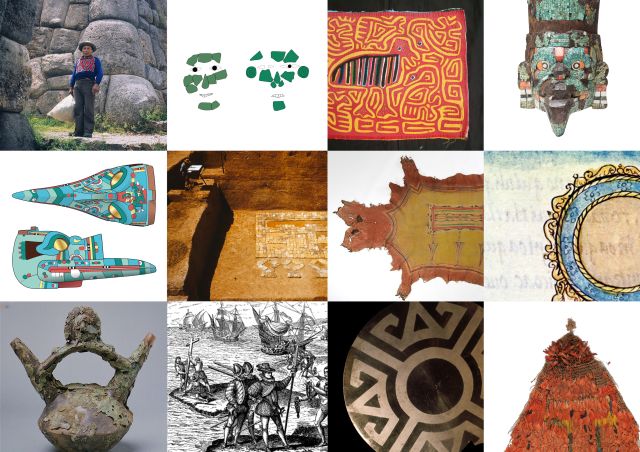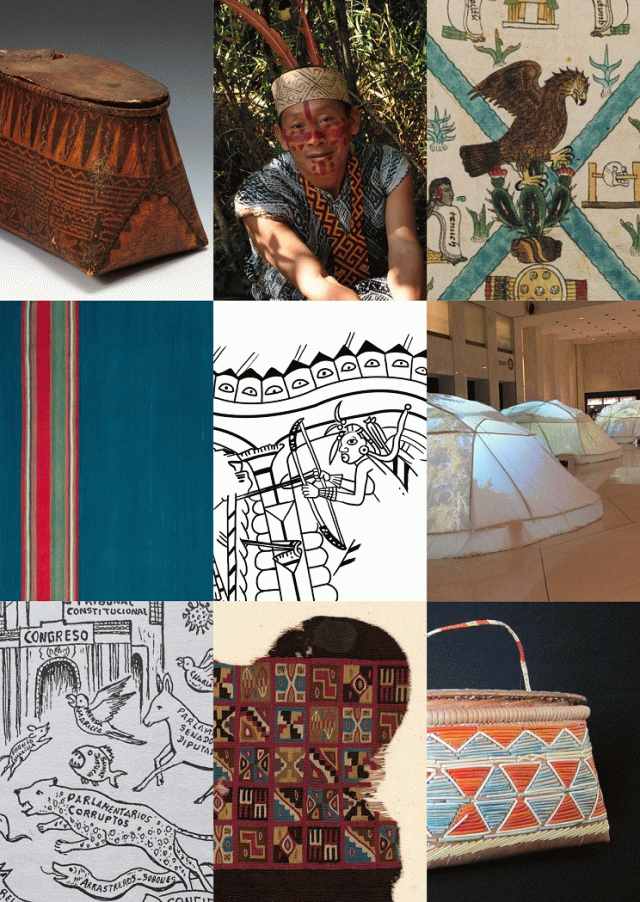Convegno
Working with stone
In the framework of the symposium Amerindian Art Histories and Archaeologies: A KHI – UCL Symposium on Material Transformations in the Indigenous Americas
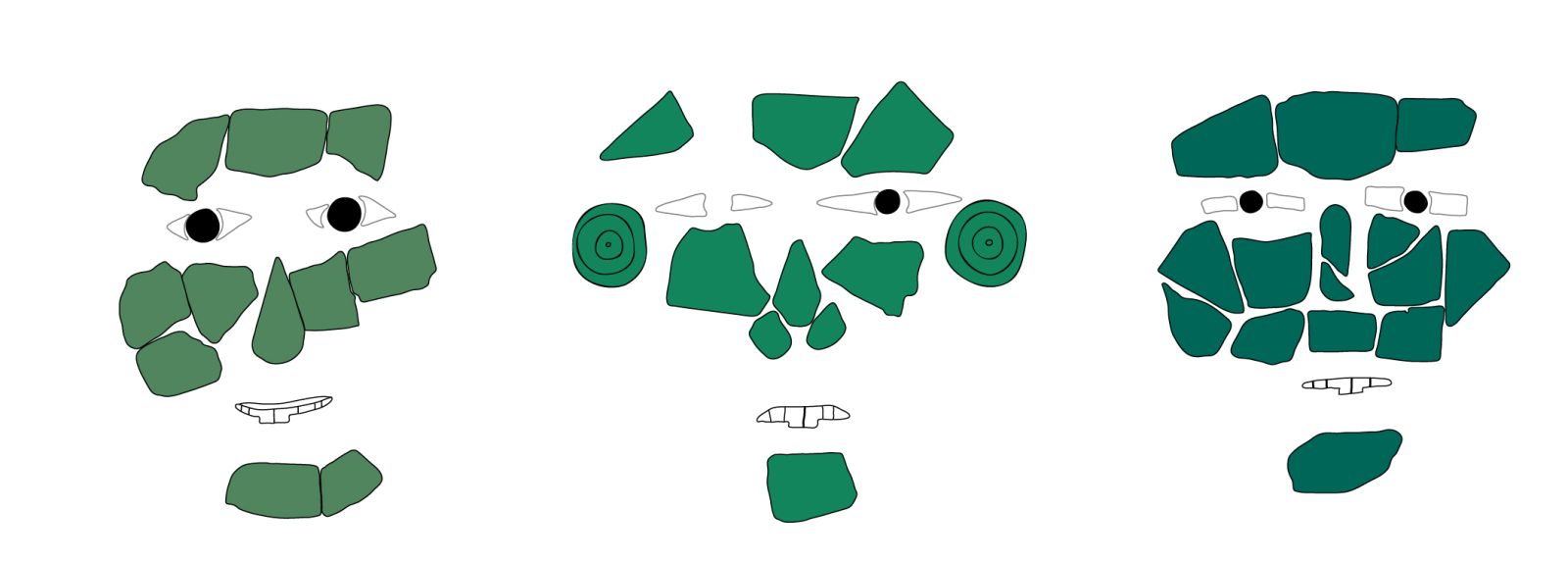
Preliminary assemblage of the greenstone mosaic masks found in the Late Classic (CE 550–800) funerary precinct of the female ruler from the ancient Maya site of Waka’ (drawing by Juan Carlos Meléndez).
Speakers
Juan Carlos Meléndez | Of stones and snakes: ancient Maya portable greenstone mosaic masks (CE 300–800)
Abstract
Greenish or bluish stone ornaments, commonly known as ‘cultural jade’ in scholarly Mesoamericanist jargon, were one of the hardest raw materials transformed by ancient artisans in Mesoamerica. For the ancient Maya, greenstone ornaments were linked to the ideas of rulership, centrality, maize, water, and the essence of life, and as such they constituted a pillar in their material world. This study focuses on ancient Maya portable greenstone mosaic masks, mostly found in funerary precincts of elite individuals, while a few were deposited in caches. Based on contextual analyses and iconography, I explore the ritual meaning and political role of these ornaments created between the 4th and 8th centuries of the current era within the area known as the Maya Lowlands. Moreover, through traceological approaches I determine the existence of a standardized manufacture of the segments (i.e., tesserae), which formed the masks when assembled in a specific order. Contrary to some mainstream notions suggesting the passive function of these ornaments solely as countenances of deities used as offerings, my study proposes their active role and diverse functions, notably as insignias of affiliation to the hegemonic regime known as Kaanul during the Late Classic (CE 550–800) and perhaps before, and possibly as ‘tokens for divination’.
Biography
Juan Carlos Meléndez received a licentiate in Archaeology from Universidad de San Carlos de Guatemala, and a PhD in Anthropology from Washington University in St. Louis. Presently, he is a postdoctoral fellow affiliated to the research unit Archéologie des Amériques UMR 8096 – CNRS / Université Paris 1 – Panthéon-Sorbonne. He was a postdoctoral fellow in the research department at the quai Branly – Jacques Chirac Museum in Paris, and was also appointed as a fellow at Dumbarton Oaks – Trustees for Harvard University. Juan Carlos has carried out archaeological field research in several ancient Maya settlements of Guatemala, and also co-directed the Waka’ archaeological project. He was the Director of the National Museum of Archaeology and Ethnology in Guatemala, and a member of the organizing committee of the Simposio de Investigaciones Arqueológicas en Guatemala (2008–12). His curatorial works have been rendered through exhibits presented in Guatemala, France and South Korea. Among his recent publications are “Of Snakes and Masks” (with David Freidel and Daniel Aquino), “Explorando las órbitas tecnológicas de dos rostros de mosaico de piedra verde de Tikal, Petén, Guatemala” (with Emiliano Melgar), and “Desentrañando los matices tecnológicos prehispánicos Mayas de un conjunto de rostros de mosaico.”
Davide Domenici | Dynamic and powerful surfaces: technology, style and aesthetics in Late Postclassic Nahua and Mixtec mosaics
Abstract
A comparative analysis of Late Postclassic Nahua and Mixtec artifacts encrusted with mosaics of precious stones and shells allows the recognition of different stylistic groups, each characterized by a peculiar use of materials and specific formal resources. In the presentation it will be argued that each stylistic group employs specific and distinctive formal strategies to create optically dynamic surfaces, able to interact with light in complex ways and, in this way, to visually express the sacred forces imbuing the mosaic-covered godly insignias. The case study allows to reflect on how, by means of specific technologies, Mesoamerican artists were able to endow their creations with meaningful aesthetic qualities.
Biography
Davide Domenici is Associate Professor of Anthropology at the Department of History and Cultures of the University of Bologna (Italy), where he teaches Museum Anthropology and Indigenous American Arts and Culture. He is a member of the teaching committee of the PhD program in Cultural Heritage in the Digital Ecosystem. As a specialist in indigenous American civilizations, Davide Domenici has been Director of the Río La Venta Archaeological Project (Chiapas, Mexico, 1998-2010) and of The Cahokia Project (Illinois, USA, 2011-2017). Over the last decade he has been studying the early modern circulation of Mesoamerican artifacts in Italy, as well as the technology of codex painting in pre-Hispanic and Colonial Mesoamerica by means of non-destructive scientific analyses. He is currently studying Postclassic Mesoamerican mosaics by conjoining scientific analyses, stylistic/iconographic studies, and provenance research. Some of his recent publications on mosaics are “The Wind God and the Descent of the Tzitzimitl. New Insights on the Iconography and Provenance of the Mosaic-Encrusted Bird Head at the Friedenstein Palace, Gotha (Germany)” (with Élodie Dupey García); “The Gaze of the Ñuhu Bundles. An Interpretation of Mesoamerican Mosaics at the National Museum of the American Indian”; “Mesoamerican Mosaics in Early European collections. Style, Provenance and Provenience”; and “The Face of Xolotl: A Unique Mosaic-covered Object in the National Museum of Denmark” (with Jesper Nielsen).
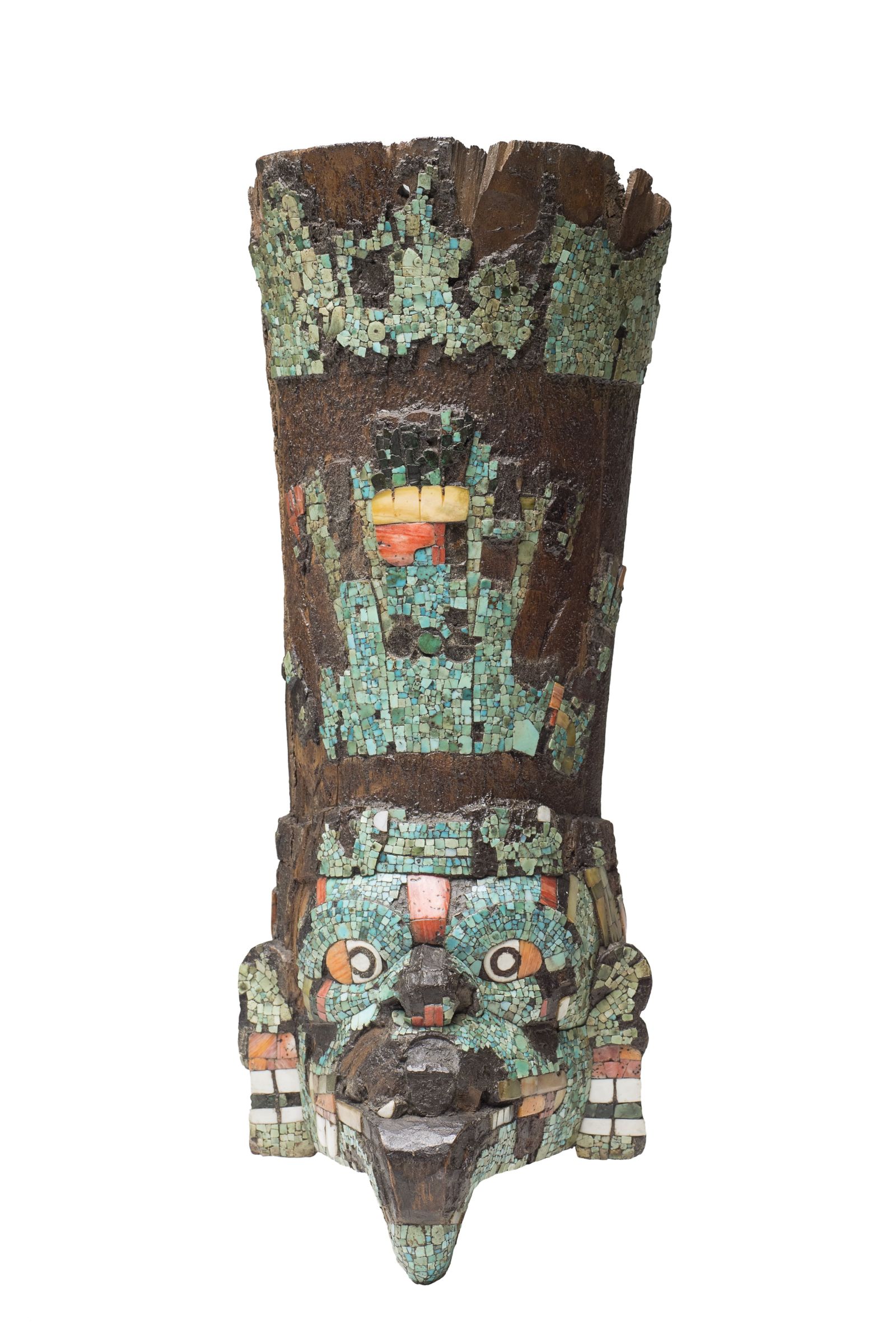
Wooden sculpture of the canine god Xolotl, encrusted with mosaic of turquoise, malachite, Spondylus sp., Strombus sp., mother-of-pearl and probably originally endowed with now-missing gold sheets. The artifact is now held at the National Museum of Denmark, Copenhagen, inv. A.424.ODIh.40 (photo by Roberto Fortuna © Nationalmuseet).
Catherine J. Allen | Andean stone: bloody, boiling and changeable
Abstract
“Bloody boiling wall!” – exclaims the boy Ernesto in a famous passage from José María Arguedas’ novel, Los Ríos Profundos (Deep Rivers).* He goes on, “the wall was stationary, but its lines were seething and its surface changeable, as that of the flooding summer rivers.” Anyone who has spent time immersed in rural Andean life will recognize the rightness of this description. And yet why and how can a stone wall be said to be ‘bloody’, ‘boiling’ and ‘changeable’ – qualities opposed to our usual associations with stone as eternal and immutable? My talk will address Andean stone and stonework within an ontological framework in which time, materiality and consciousness are intimately interrelated. Petrification, the transformation of living bodies into stone, is not a single event in mythic time but an ongoing process that imbues certain stones with powerful agency. This affects how stones are approached, dressed and addressed, and joined with other stones to make walls.
* Arguedas, José María, 1978 [1958]. Deep Rivers (Los Ríos Profundos, transl. by F. H. Barraclough). Austin: University of Texas Press, p. 7.
Biography
Catherine J. Allen (PhD University of Illinois, 1978) is a cultural anthropologist with a deep interest in the relationship between the Andean present and the Pre-Columbian past. She is author of The Hold Life Has: Coca and Cultural Identity in an Andean Community (Smithsonian Press 1988, 2nd ed. 2002), an ethnography concerning the roles of coca leaf and alcoholic beverages in contemporary Andean ritual. In Foxboy: Intimacy and Aesthetics in Andean Stories (University of Texas Press 2011) she explores expressive strategies in Quechua story-telling and other modes of artistic expression. Other publications include studies of Pre-Columbian iconography and an ethnographic drama Condor Qatay: Anthropology in Performance (co-authored with Nathan Garner, Waveland Press 1996). Allen is Professor Emerita at George Washington University, where for over thirty years she taught courses on South American ethnography, anthropological theory, and the anthropology of art.
Zachary Hruby | Discussant
Biography
Zachary Hruby studies the archaeology of both Mesoamerica and North America with specializations in the Maya area (southern Mexico, Guatemala, and Honduras) and the American West (California, Nevada, and the Pacific Northwest). Of particular interest is Mesoamerican and Maya religion as it is materialized in the archaeological record through ancient Maya texts (epigraphy), art (iconography), and ritual deposits (caches and burials). Hruby has carried out obsidian and flint analysis at well-known Maya sites over the past twenty-five years, including Piedras Negras, El Peru-Waka, El Zotz, Holmul, Kaminaljuyu, Ucanal, and Motul de San Jose in Guatemala, Palenque, Chunchucmil, and Vista Alegre in Mexico, and Copan and Rio Amarillo in Honduras. His goals are to understand broad economic patterns across the ancient Maya world and through time, as well as symbolism associated with lithic goods (jade, flint, and obsidian) from ritual contexts. He has published extensively, including the edited books: Stones of Fire and Sky: The Symbolism of Ceremonial Lithics in the Maya Area and Beyond (forthcoming); Crafting Celestial Fire in Classic Mesoamerica: The Technologies of Ceremonial Chipped-Stone Production (forthcoming); The Technology of Maya Civilization: Political Economy and Beyond in Lithic Studies (with Geoffrey Braswell and Oswaldo Chinchilla, 2011); and Rethinking Specialization in Complex Societies: Archaeological Analysis of the Social Meaning of Production (with Rowan K. Flad, 2007).
The KHI – UCL symposium convenes art historians, archaeologists, anthropologists and curators who share interests in the transformative potential of matter and materials stemming from different social and aesthetic practices. These practices are manifest in creative works produced by indigenous peoples across the Americas from ancient times to the present. In each of the four sessions, three researchers will bring into conversation case studies from a diverse set of indigenous cultural traditions and address a specific type of materiality. Namely, they will address the materiality of stones, metals, colour, as well as multi-materiality and multisensory creations and experiences, their functions, uses and reception from ancient, colonial and contemporary indigenous societies from Brazil, the Central Andes, Panama, Mesoamerica and North America. It is organized by Sanja Savkić Šebek (KHI in Florenz – Max-Planck-Institut & Humboldt-Universität zu Berlin) and Bat-ami Artzi (CSoC, Ben-Gurion University of the Negev; former 4A_Lab Fellow), in collaboration with Elizabeth Baquedano (UCL Institute of Archaeology).
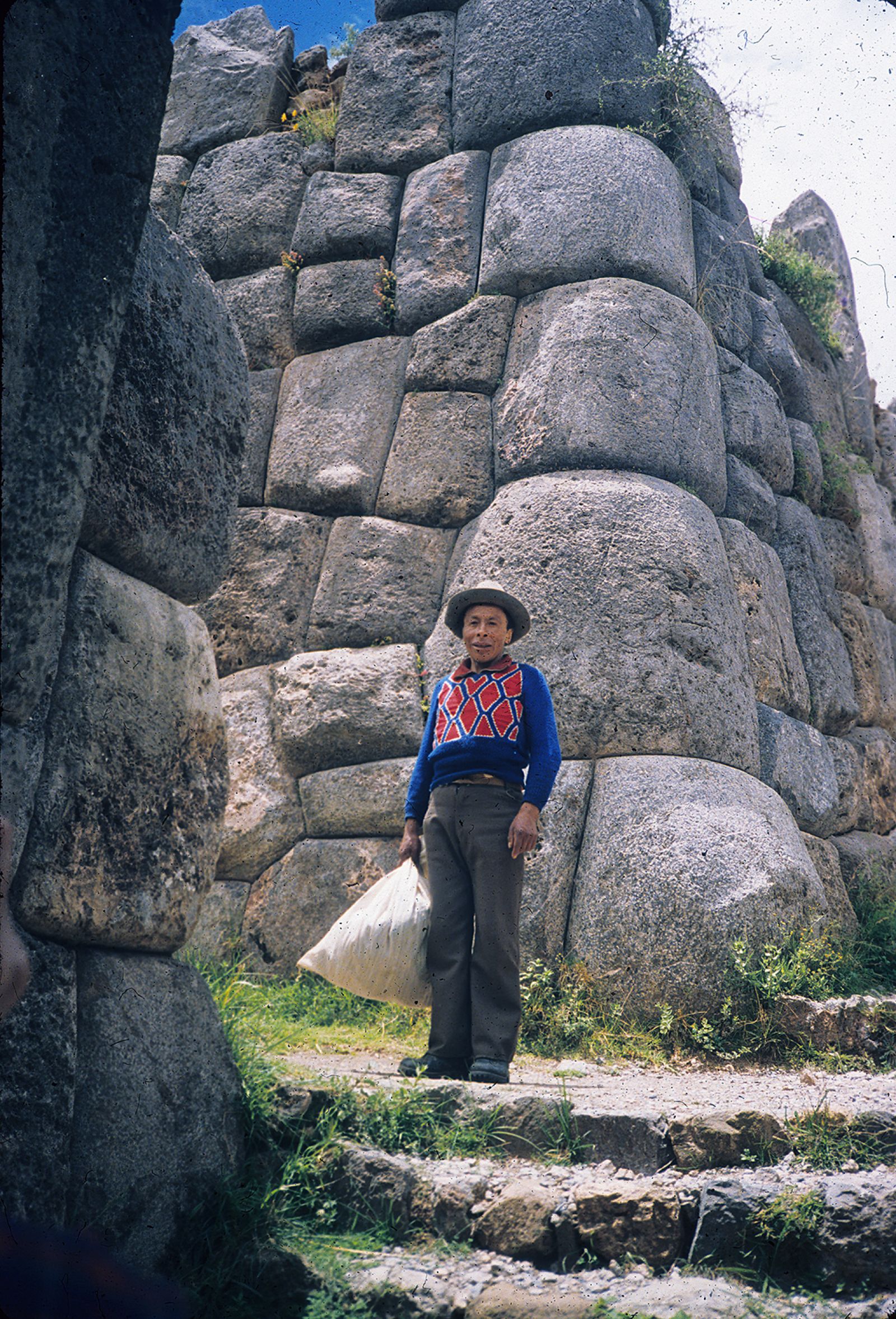
Visiting the Inka site of Sacsayhuaman (Cusco, Peru) with Luis Gutiérrez in 1985 (photo by Catherine J. Allen).
08 febbraio 2023, ore 17:00
The event will take place online.
To participate please register in advance via Zoom: https://zoom.us/meeting/register/tJwscO-vrD8qGdSrcG0NHaOvPCUowf21XuiE
After registering, you will receive a confirmation email containing information about joining the meeting.
Avviso
Questo evento viene documentato fotograficamente e/o attraverso riprese video. Qualora non dovesse essere d’accordo con l’utilizzo di immagini in cui potrebbe essere riconoscibile, da parte del Kunsthistorisches Institut in Florenz a scopo di documentazione degli eventi e di pubbliche relazioni (p.e. social media) la preghiamo gentilmente di comunicarcelo.



